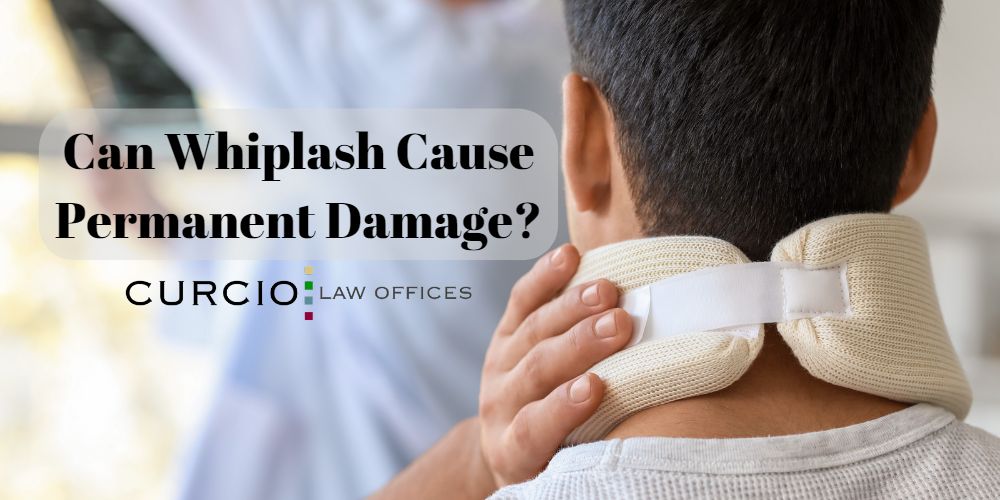Major car accidents can cause major damage, but what about minor accidents? Most people don’t think that fender benders can cause permanent damage to your car or your person, but this is incorrect. In fact, whiplash injuries can happen when traveling at only five miles per hour. If you or a loved one has suffered a whiplash injury, you may have a lot of questions on your mind. The main one may even be “Can whiplash cause permanent damage?” At Curcio & Casciato, our auto accident attorneys can help answer your most pressing questions. Read on below to find out more about whiplash and how it can have devastating effects.
What is Whiplash?
Whiplash is a soft-tissue neck injury that affects the cervical spine. There are vulnerable joints, discs, ligaments, and nerve roots in the neck. When these delicate parts of the neck suffer a traumatic accident, the effects can be lifelong. Whiplash happens most often in car accidents; the sudden stop causes your head and neck to continue moving forward, but your seatbelt acts against this force and snaps you back into your seat. This sudden, forceful motion can cause severe pain, but it can also cause a deeper injury that may not surface for a few days.
How Does a Whiplash Injury Happen?

In most cases, a whiplash injury occurs during a car accident. Let’s say you’re driving along and come to a stop at a red light. The driver behind you is distracted and doesn’t notice that you’ve stopped. They rear-end you. The motion forces your car forward and your head snaps back against your seat. The car stops, but your body continues moving forward. Your seatbelt does its job and keeps your body restrained, but your head snaps forward. This all happens in the span of a few seconds. The sudden force against your neck muscles causes a whiplash injury.
While car accidents are the most common cause of whiplash injuries, they are not the only cause. Other common causes include:
- Sport injuries
- Amusement park rides
- Physical abuse
- Slip and fall accidents
Is Whiplash Common?

As many as 3 million Americans suffer from a whiplash injury every year. It’s safe to say this injury is incredibly common. Severe whiplash affects as many as half of these whiplash victims. A whiplash victim isn’t always the driver in a car accident; whiplash can affect all passengers as well.
Whiplash Symptoms
The most significant whiplash symptom for many people is neck pain, but this isn’t the only symptom. Sometimes the pain can show up immediately after the accident, but sometimes it can take a few days for all the symptoms to appear. Whiplash injuries are classified based on the grade of injury. This grading system is called the Quebec Classification of Whiplash-Associated Disorders. This system allows medical providers to determine the extent and severity of the injury.
Grade 0
People with a Grade 0 injury won’t have any pain or symptoms of whiplash. The injury may appear on x-rays or other scans, but the injury isn’t severe enough to cause pain.
Grade 1
A Grade 1 injury is when a person feels pain. This level of injury often includes symptoms like stiffness and tenderness.
Grade 2
A Grade 2 injury will often have physical signs, such as bruising and swelling. Grade 2 injuries often include muscle spasms and pain that radiates to the head, shoulders, or back.
Grade 3
A Grade 3 whiplash injury often has neurological symptoms. Swelling at the injury site can cause pressure on your spinal cord, which can lead to issues like:
- Vision problems
- Dizziness
- Numbness in the neck, upper back, and shoulders
- Headaches
- Muscle weakness
- Burning or tingling in the hands, neck, back, and/or arms
Grade 4
A Grade 4 injury is the most severe form of whiplash. This injury often involves severe pain and neurological symptoms. At this stage, it’s not uncommon to see a broken or fractured vertebra. This often puts pressure on the spinal cord and other nerves, causing short-term paralysis and pain.
Whiplash Treatment

There’s no cure for whiplash, only treatment. The treatment that your doctor chooses often depends on a few different factors. The cause of your injury, the severity, and your lifestyle can all change your treatment options. The most common types of treatment are listed below.
- Medication
- Cold/heat therapy
- Immobilization
- Physical therapy
- Surgery
Long-Term Effects of Whiplash

Whiplash injuries often heal in a few days to a few weeks, but some whiplash victims experience lasting symptoms. According to a 2001 study, nearly 8% of whiplash victims have continuing symptoms for more than a year after the accident that affect their ability to return to their normal living activities. A severe injury is more likely to cause chronic neck pain and severe headaches. Other long-term effects can include:
- Jaw pain
- Dizziness
- Vision problems
- Difficulty sleeping
- Tinnitus
- Numbness in arms/legs
Chronic pain can make life significantly more difficult. Many people are unable to cope with this constant pain. Some people have a higher risk of developing chronic whiplash after a traumatic experience.
Risk Factors for Long-Term Whiplash Injuries

Long-term whiplash is more likely to happen with severe initial injuries, but this isn’t the only risk factor. Rear-end auto accident victims are more likely to experience long-term issues with whiplash. Vehicle construction, height, and muscle differences can also contribute to whiplash injuries as well. Women and adults over 65 are the groups most likely to experience long-term whiplash injuries.
What Do I Do After a Whiplash Injury?

Any kind of accident can be confusing and overwhelming. Knowing what to do after an accident can protect your chances of recovering compensation. Below, we’ve outlined the most important steps to take after an accident.
Seek Medical Attention Immediately
Seek medical treatment as soon as possible after any kind of accident. Proper medical care can limit your injuries and lessen your recovery period. It’s not uncommon for whiplash injuries to appear days after the accident, so it’s critical to get evaluated by a medical professional as soon as possible. Proper medical care can also ensure that you get the compensation you deserve in personal injury claims. Insurance companies can claim that you made your injury worse by not seeking medical treatment and will try to push responsibility onto you.
Document, Document, Document
Keep records of everything pertaining to the accident or your injuries. You never know when you’ll need information to prove aspects of your case. Keeping a detailed journal of events, symptoms, and other information can be used as evidence later in your case. Tracking your symptoms can also help your doctor develop the best treatment plan for you and monitor your progress.
Contact the Personal Injury Attorneys at Curcio & Casciato
Personal injury claims can be difficult and confusing, especially as you’re recovering from an injury. The personal injury attorneys at Curcio & Casciato are ready to support you through every step of this legal process.
Call the Whiplash Injury Attorneys at Curcio & Casciato Today
If you or a loved one is suffering from a whiplash injury, contact the whiplash injury attorneys at Curcio & Casciato. We can help fight for the compensation you need to recover from this devastating injury. Our attorneys are familiar with whiplash injuries and the way insurance companies try to undervalue them. It’s never too soon to call us, so schedule your free consultation by calling us at (312) 321-1111.



